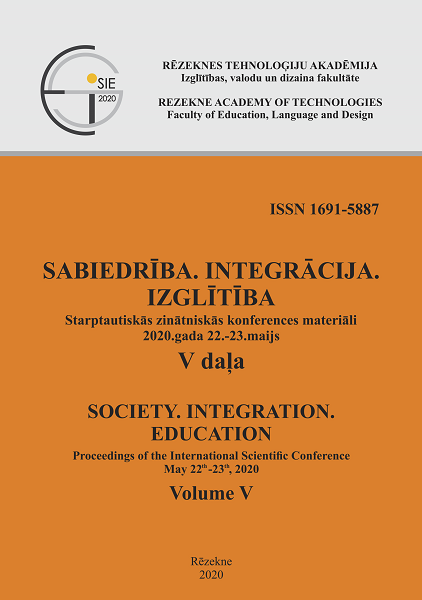CLIL AND GLOBAL EDUCATION: A MEANINGFUL MATCH
DOI:
https://doi.org/10.17770/sie2020vol5.4819Keywords:
CLIL, critical thinking, creativity, global skills in education, intercultural competence, language teacher trainingAbstract
Education for future necessarily embraces multiple skills and themes which are transversal and applicable across the curriculum content. Students need to see and understand the content of individual subjects as connected and not as a discrete entity. CLIL as an approach which focuses on integration of meaningful context into a language learning classroom has been tested over the last decades and demonstrates that communication does not necessarily need to be limited to vocabulary and grammar practice. On the contrary as one of the global skills communication supports social interaction in problem solving, collaboration and thus is the key skill in achieving target goals. This study focuses on the readiness to implement the global skills within the CLIL approach among trainees in their last year of teacher training in Slovakia in 2019. The questionnaires and the subsequent interviews reveal that future language teachers still seem to prefer focusing on pure language aims to integrating global skills development and they even lack the confidence in application of transversal themes and skills. Even though there is a clear understanding of the importance of integration of global skills into education in general the lack of their own experience seems to determine their attitude towards them. These results identify the space for modification in the teacher training curriculum; however, it requires a wider cooperation within different subjects.
Downloads
References
Cenoz, J. (2013). Discussion: towards an educational perspective in CLIL language policy and pedagogical practice. International Journal of Bilingual Education and Bilingualism, 16:3, 389-394, DOI: 10.1080/13670050.2013.777392
Cimermanová, I. (2015). Creativity in EFL teacher training and its transfer to language teaching. Proceedia - Social and Behavioral Sciences, 197, 1969-1975.
Cimermanová, I. (2017). CLIL – a dialogue between the language and subject teachers. Scientia et eruditio 1(1), 1-14. Retrieved from: http://pdf.truni.sk/see/issue?2017-en&natural-sciences#CIMERMANOVA.
Cummins, J. (1998). Immersion education for the millennium: What have we learned from 30 years of research on second language immersion? In M. R. Childs & R. M. Bostwick (Eds.), Learning through two languages: Research and practice. (34-47). Katoh Gakuen, Japan.
Díaz-Pérez, F.J. (2013). Introduction to Global Issues in the Teaching of Language, Literature and Linguistics. In Díaz-Pérez, F.J., Belén Díez-Bedmar, M., García-Ramírez, P. & Rascón-Moreno, D. (Eds.), Global Issues in the Teaching of Language, Literature and Linguistics (7-14). Bern: Peter Lang AG.
Dalton-Puffer, Ch. (2011). Content-and-Language Integrated Learning: From Practice to Principles? Annual Review of Applied Linguistics, 31, 182-204.
Jakar, V. (2004). Promoting global issues. GISIG Newsletter 16, 24–26.
Klieme, E., Hartig, J., & Rauch, D. (2008). The Concept of Competence in Educational Contexts. In J. Hartig, E. Klieme & D. Leutner (Eds.). Assessment of Competencies in Educational Contexts (3-22). Ashland: Hogrefe & Huber publishers.
Lasagabaster, D. (2011). English achievement and student motivation in CLIL and EFL settings. Innovation in Language Learning and Teaching 5(1), 3-18. DOI:10.1080/17501229.2010.519030
Lasagabaster, D., & Sierra, J. M. (2010). Immersion and CLIL in English: More Differences than Similarities. ELT Journal 64 (4), 367-375. DOI:10.1093/elt/ccp082
Llinares, A. (2015). Integration in CLIL: a proposal to inform research and successful pedagogy. Language, Culture and Curriculum 28 (1), 58-73.
DOI: 10.1080/07908318.2014.1000925
Lorenzo, F., Casal, S., & Moore, P. (2010). The effects of content and language integrated learning in European education: Key findings from the Andalusian bilingual sections evaluation project. Applied Linguistics 31, 418-442.
Marsh, D. (2002). CLIL/EMILE: The European Dimension-Actions, Trends and Foresight Potential. Retrieved from: https://jyx.jyu.fi/bitstream/handle/123456789/47616/1/david_marsh-report.pdf
Marsh, D. (2006). English as medium of instruction in the new global linguistic order: Global characteristics, local consequences. In Stewart, S. M., Olearski, J. E., & Thompson, D. (Eds.), Proceedings of the Second Annual Conference for Middle East Teachers of Science, Mathematics and Computing (29-38). Abu Dhabi: METSMaC.
Mehisto, P. (2008). CLIL Counterweights: Recognising and Decreasing Disjuncture in CLIL, International CLIL Research Journal 1(1), 96-117.
Mehisto, P. (2012). Criteria for producing CLILlearning material. Encuentro, 21, 15–33.
Met, M. (1998). Curriculum decision-making in content-based language teaching. In Cenoz, J., & Genesee, F. (Eds.), Beyond bilingualism: Multilingualism and multilingual education (35–63). Clevedon: Multilingual Matters.
OECD. (2016). Definition and selection of competencies. (DeSeCo). Retrieved from: http://www.oecd.org/education/skills-beyond-school/definitionandselectionofcompetenciesdeseco.htm
Pokrivčáková, S., Menzlová B., & Farkašová E. (2010). Creating conditions for effective application of CLIL methodology in Slovakia. In: Modernization of Teaching Foreign Languages : CLIL, Inclusive and Intercultural Education (23-28). Brno: Masarykova univerzita.
Pokrivčáková, S. (2013). CLIL Research in Slovakia. Hradec Králové: Gaudeamus, University of Hradec Králové Press.
Rascón-Moreno, D. (2013). Combining Global Issues and English Teaching. In Díaz-Pérez, F.J., Belén Díez-Bedmar, M., García-Ramírez, P., & Rascón-Moreno, D. (eds.), Global Issues in the Teaching of Language, Literature and Linguistics (15-38). Bern: Peter Lang AG.
Ridder, J. W. H. (2004). Letter from the acting SIG Coordinator. GISIG Newsletter 16, 3–4.
Ruiz de Zarobe, Y., & Cenoz, J. (2015). Way forward in the 21st century in content-based instruction: moving towards integration. Language, Culture and Curriculum 28(1), 90-96. DOI 10.1080/07908318.2014.1000927
Rychen, D.S., & Salganik, L.H. (Eds.). (2003). Key Competencies for a successful life and well-functioning society. Ashland: Hogrefe & Huber Publishers.
Sepešiová, M. (2015). CLIL lesson planning. In: Modernization of Teaching Foreign Languages : CLIL, Inclusive and Intercultural Education (131-152). Brno: Masarykova univerzita.
Sylvén, L.K. (2013). CLIL in Sweden – why does it not work? A metaperspective on CLIL across contexts in Europe. International Journal of Bilingual Education and Bilingualism 16(3), 301-320. DOI: 10.1080/13670050.2013.777387
UNESCO. (2007). Education for Sustainable Development Goals: Learning Objectives. Paris, France, Retrieved from: http://unesdoc.unesco.org/images/0024/002474/247444e.pdf
Urmeneta, C.E. (2013). Learning to become a CLIL teacher: teaching, reflection and professional development. International Journal of Bilingual Education and Bilingualism 16(3), 334-353. DOI: 10.1080/13670050.2013.777389
Wiek, A., Withycombe, L., & Redman, C. L. (2011). Key competencies in sustainability: a reference framework for academic program development. Sustain Sci., 6, 203-218. DOI: 10.1007/s11625-001-0132-6.


